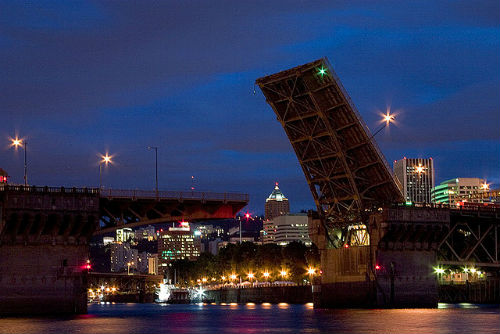Open—Wide Open—in Portland: A FOSS4G Review
by Brian Timoney
Having been to previous FOSS4G conferences—2007 in Victoria, 2011 in Denver—I was eager to circle back to this year’s iteration in Oregon to assess what’s changed, what’s new, and what I can adapt for everyday use in my consulting business.
I. Sprawl
With up to eight tracks running simultaneously, everyone’s conference was going to be different. But knowing that all the sessions would be available on video, one could take more “chances” with the unusual-sounding and catch up later with the more familiar (PostGIS, MapServer,etc. ) later. Be honest, how many conferences leave you eager to review another few hours of talks a week later?
II. Open Source Is A Development Strategy, Not A Price Point
The biggest cultural change from 2011’s FOSS4G ?
GitHub.
We all know what open source is and don’t have to address the legacy stereotype of open source participants as an exotic tribe of code natives uncorrupted by the ordinary lures of the market economy. Everyone has a GitHub account, from your favorite 3-letter acronym government agencies to your other favorite 4-letter geospatial vendor. With this new broad understanding of the open source model comes the opportunity to have a richer conversation about the efficacy, adoption, and sustainability of the tools–themes touched on by keynoter Mike Bostock.
III. Remember the Browser Wars? The Browser Won.
By far the greatest impression was made by the WebGL and the manifold possibilities of powerful applications that run in the browser with no plugins. The technology itself is a little trippy with shaders and meshes made up of points, lines, and triangles. Except you actually want to render your lines as triangles too (don’t ask).
Life was easy when there were hard-and-fast distinctions between Server, Desktop, and Web. Then along came the mobile web.
Now we have the dominance of the browser.
Database? It’s inside your browser. With spatial features. That are spatially indexed.
Spatial operations? Inside the browser. Hefty on-the-fly rendering? Inside the browser.
Let me throw out three implications:
- the “basemap” is dead—your whole map, base features and thematic overlays—is being rendered on-the-fly. If we were at the dawn of a new Golden Age of Cartography a couple of years ago, I suspect we ain’t seen nothing yet.
- the web is no longer synonymous with “connected to the Internet”. The use-case that kept cropping up was the new user expectation that their web app would keep working when disconnected from the interwebs and seamlessly sync with a canonical datastore when connectivity was restored.
- no install software, because the browser is the operating system. Anyone whose business required the tender mercies of Enterprise IT to install software will appreciate a more direct connection to end users via the browser. It’s one of those nudges that amplifies open source software’s natural advantages in rapid deployment and fast iterations.
IV. No Paint-by-Numbers Business Models
Just as diverse as the tools on offer were the ways of incorporating open source to make money. While funded startups Mapbox and CartoDB certainly commanded a great deal of attention, the true breadth of geospatial open source was perhaps best seen towards the margins. Cloudant, recently acquired by IBM, talked up its platform in the context of PouchDB and the burgeoning smart car market. The Climate Corporation, largely fueled by open weather and agricultural data ( acquired last October by Monsanto for $1.1B—yes, that’s a ‘B’ ) presented a bit on better spatial indexing in the Lucene/Solr/ElasticSearch family of search technology. What’s clear is that far from stale cliche of open-source-as-hippie-altruism, FOSS4G encompasses a much richer variety of possible income models than the increasingly cramped GIS-software-and-services subset.
V. Location, Location, Location
With the logistics of the event well organized from top-to-bottom, I’d be remiss if I didn’t compliment the host city itself.
Sized quite manageably for visitors, Portland is one of the few US cities you can show off proudly to your Progressive Urbanist friends: ubiquitous public transit, Dutch levels of citizen cycling, high taxes, and restrictive zoning (edited for politeness).
And the weather belied the cliched stereotype of the rainy northwest: a week 80F temps and bright sunshine. Reminded me of San Diego.
—Brian Timoney


